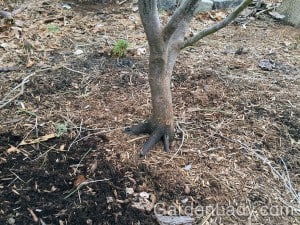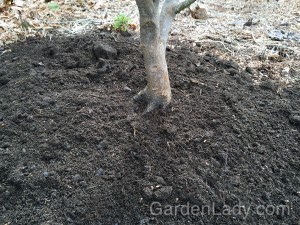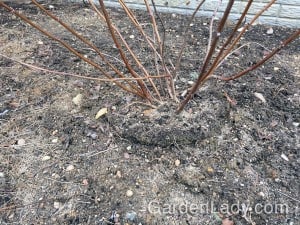Some of my callers to The Garden Lady have asked, “What should I be doing this early in the spring?” When the season is just beginning it’s invigorating to be outside in the yard and garden, so I applaud their desire to know what they can do, and which tasks it’s too early to address. There are several things that we can do that will help the garden as the growing season progresses. Here are a couple of the garden to-do items I noticed and addressed today.
The first thing that we can accomplish any time the ground isn’t frozen is to pull weeds. In fact, in the perennial garden it’s one of the best times for this because many of the weeds are already up while the plants we want might not have started to grow.

See the small tufts of grass in this aster bed? Once the asters break dormancy and start growing it will be harder to see and pull these weeds. Now is my window of opportunity, aka Weed WOO!

As I walk around the yard I can see things that might be hidden by foliage once the growing season starts. I noticed that the ground has settled a great deal around this maple tree. Although maples like to be planted high, and have their root-flare visible, I decided that a half-inch covering of loam and compost would be good around this tree. If you want to spread loam or compost in a garden, doing so early in the season before any mulch goes down is a good idea.

Here is how the finished layer looks. It will settle down and become a bit more compact after a few rains, so I know that the root flare at the base of this tree will still be quite visible.
Another thing that might catch your eye in the spring is perennials that have heaved up out of the ground in the winter, or fall-planted shrubs and trees that have done the same thing. A clump of daylilies, for example, might be suddenly higher in the perennial garden. Today I noticed that a fall planted Invincibelle Spirit 2 Hydrangea that we put in the ground last September was now a bit too high. The ground around the rootball had settled over the winter, and perhaps the freezing and thawing had heaved the plant up a bit.

If you can clearly see the edges of the rootball as if the plant was still in a pot, you need to add some more soil around the edges of the root circle. When a plant is put into the ground it might look as if it’s at the same level as the soil around it, but once things settle, or heaving takes place over the winter, we notice that more soil is required.

I shoveled a mix of loam and compost around this plant. Since this Hydrangea is a cane grower (sending up multiple stems from ground level) I don’t have to be too worried that there is some soil around the base of each stem. This type of shrub isn’t as picky as that maple tree we just saw when it comes to having stems with soil around them. This layer of compost and loam will also settle into a coating that is less than an inch but deep enough to cover the edges of the root ball. A bit later in the season we can spread mulch over this bed as well.


Several weeks ago on your radio show, you said we didn’t have to do it all at once! It was a light bulb for me—I garden with a disability, and spring work was always a challenge.. Now, I’m out there enjooying the work, an hour at a time. Thanks for what was such an obvious solution.
Susan – I’m SO pleased that this was helpful for you. So many times in life we make something “all or nothing” and this alone almost guarantees that nothing happens. I know that if I waited for the chance to weed an entire bed, put everything in the ground or get every shrub pruned that nothing is indeed what would get done in my gardens. Happy spring!